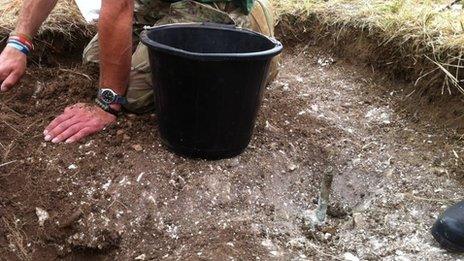Crashed WWII Spitfire being dug up on Salisbury Plain
- Published
Dave Hart "To be able to do this as a veteran - really honoured to do so"
The remains of a buried Spitfire aircraft shot down over Wiltshire during World War II are being dug up.
In 1940, Pilot Officer Paul Baillon baled out of the aircraft, and the wreckage has been buried in the earth of Salisbury Plain since.
Now a team of archaeologists, injured soldiers and veterans have begun a project to retrieve the wreckage, which is not expected to be recognisable.
The pilot's daughter, Rosemary Baillon, is also on site to watch the work.
'Enemy aircraft'
She said: "At the first threat of war, my father joined the Royal Air Force volunteer reserve and learned to fly at Sywell, Northamptonshire.

Paul Baillon was a Spitfire pilot with the 609 Squadron
"It was on 27 October 1940 that my father was brought down by enemy aircraft near Upavon.
"This was a particularly worrying time for my mother who was expecting me to be born in the March of the following year."
It is believed the 609 Squadron pilot baled out after damage to the plane's oil tank meant visibility was severely reduced, and he could not land safely.
Pilot Officer Baillon came through the Battle of Britain but was shot down over the Solent on 28 November. His body washed up on the French coast several weeks later. He is buried in the Bayeaux War Cemetery.
The project to unearth the Salisbury Plain wreckage, called Tally Ho, is being carried out by Operation Nightingale - an initiative established by the Defence Infrastructure Organisation (DIO) and The Rifles.
It helps injured personnel return to their regiment or prepare for civilian life.
'Sacrifices of airmen'
Richard Osgood, DIO's senior historic adviser, said the project had been poignant and moving.
"Archaeology is all about people - whether they be prehistoric, Roman or Saxon," he said.
"This site has yielded traces relating to the sacrifices of airmen from the 1940s and it has been a real privilege to re-tell the story of Paul Baillon.
"The Protection of Military Remains Act protects these sites and it is important that they are considered properly.
"This is avowedly the case in this instance and it is thanks to the hard work of the British service personnel and volunteers involved."

Rosemary Baillon, the pilot's daughter, is on site to watch the dig begin
- Published29 June 2013
- Published17 May 2013
- Published5 January 2013
- Published2 November 2012
- Published6 August 2012
- Published28 June 2012